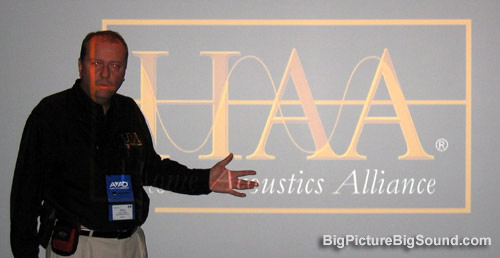HAA Shows Importance of Room Treatment and Calibration at CEDIA Expo
By Chris Boylan
One of the more effective demos at the Home Entertainment Expo in June was the Rives Audio/Ultimate A/V demonstration of the value of
room treatment to a high-end home theater system. At CEDIA Expo in Denver this year, the
HAA (Home Acoustics Alliance) took this a step further showing one room that was simply calibrated for level and speaker distance, and comparing this to a room which was not only acoustically treated and properly calibrated (using a parametric EQ for the smoothest bass response) but where the audio equipment and layout of the seating in the room were also optimized for home theater.
The HAA is a professional training and certification organization dedicated toward home acoustics. Graduates of the program are certified as Level I or Level II calibration professionals, depending on the level of training completed.

The Home Acustics Alliance trains and certifies home theater professionals.
In order to try to keep the playing field in the demo fairly level, the cost and pedigree of equipment in each room was comparable (in the $80,000 to $100,000 range), with high-end audio and video gear on loan from the likes of Stewart Filmscreen, Triad, Runco, Niveus and Audio Control. But the treated room included approximately $5,000 worth of room treatments from Quest and RPG, with calibration and speaker placement done by HAA Level II calibration professionals. Music and movie tracks were used in each room, including a scene from the BMW short film "The Hostage" as well as clips from "The Fifth Element" and "Alexander."
In the untreated room, a single pair of dipole surround speakers was used for the rear channel, while the treated room included two pairs of direct radiators instead. While the standard wall-mount solid screen in the untreated room required that the speakers be placed well below the main speakers, a micro-perf screen was used in the optimized room so that the front speakers could all be placed on the same plane (with the center channel placed behind the screen), Also a riser was built in the optimized room. so that all three rows of audience members could have an unobstructed view of the screen as well as a direct audio path from speakers to ears.

In addition to showcasing the importance of proper room treatment, HAA demonstrated that the human body does not make the best projection screen surface.
This demonstration was very effective at conveying the importance of a well-thought out home theater design, not just the components, but the placement and optimization of these components in the room and treatment of the room to be as sonically neutral as possible. I noticed vastly improved imaging, dialog audibility and bass response in the calibrated room. The only negative was that the perforations of the screen were visible to me on some content, but there are sonically transparent woven screens that can eliminate this problem.
Bottom line: if you're investing thousands of dollars into a home theater system, in a dedicated room or not, you should consider hiring a consultant to evaluate the design and acoustics of your room, measure it once everything is installed and incorporate the proper room treatments and/or electronic processing so that you'll get the highest possible performance out of your components.

